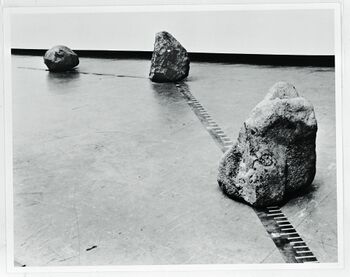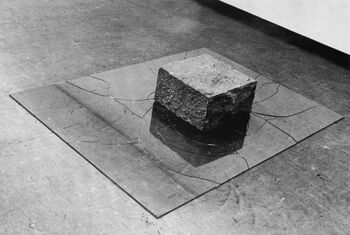Mono-ha
Mono-ha was an art movement based in Japan, active from around 1968 to 1975.
Historical note[edit]
This section is taken from the statement published on the website of Nobuo Sekine.
The Mono-ha artists tended to present natural and industrial materials such as stone, soil, wood, paper, cotton, steel plates, and paraffin—”things” (mono)—on their own or in combination with one another. Contrary to the mainstream anti-art tendencies of Zenēi Bijutsu (avant-garde art), Mono-ha attempted to reconfigure art through the reduction of objects to their primary form. Unaltered, natural matter and objects were considered not as material, but in and of themselves significant and autonomous. Attempts were made to draw out a kind of artistic expression from matter by directly engaging in its being (ari-yō), perception, and relations.
In 1968, assisted by his friends, Nobuo Sekine constructed an earthwork titled Phase—Mother Earth for the first Suma Rikyu Park Contemporary Sculpture Exhibition in Kobe. Among his friends were future Mono-ha artists Susumu Koshimizu and Katsurō Yoshida, both students at Tama Art University (Tamabi) at the time. Prior to the exhibition, the three briefly shared a warehouse space in Yokohama at Sekine’s urging, while Tamabi was on lockdown during the student movement. Kishio Suga and Shingo Honda, attending Tamabi at the same time, were also present. The unveiling of Phase—Mother Earth proved to be a critical moment in the development of Mono-ha, initiating a period of intense activity for those involved in the movement.
Sekine met artist Lee Ufan, six years his senior, in Shinjuku several weeks following Kobe. Drawn to Lee’s interpretations of his work based on the theories of Heidegger and Kitarō Nishida of the Kyoto School, Sekine introduced Lee to his circle of friends, and arranged regular group meetings at “Top,” a cafe by Nishi-Shinjuku Station. Over the course of a year and a half, what were to become the basic tenets of Mono-ha formed through continuous dialogue. Constant aesthetic assertions informed by these debates became indispensable to the formation of Mono-ha. Discussions revolved around questions of how to transcend Western Modernism by ending representation, a sentiment endemic to postwar Japan, a re-examination of indigenous culture as a means to bring attention to the physicality of “things,” and the limits of creativity.
Artists noted for their participation in Mono-ha include Kōji Enokura, Noriyuki Haraguchi, Shingo Honda, Susumu Koshimizu, Lee Ufan, Katsuhiko Narita, Nobuo Sekine, Kishio Suga, Noboru Takayama, Katsurō Yoshida, and Jirō Takamatsu.
Historically, Mono-ha shared many commonalities with Supports/Surfaces in France, Arte Povera in Italy, and Minimalism in the United States.
Publications[edit]
- roundtable discussion in Bijutsu techō 436 (Feb 1970). (Japanese)
- Ba sō ji/Place-Phase-Time: Open, May 1970. Self-published booklet; includes b&w reproductions of works by Lee, Sekine, Yoshida, and Shingo as well as critical texts by Lee and Tokyo-based American art critic Joseph Love.
- Lee Ufan, "Chokusetsu genshō no chihei ni: Sekine Nobuo-ron", SD 74 (Dec 1970), pp 2-96, and SD 75 (Jan 1971), pp 119-123; rev. & exp. as "Sonzai to mu o koete: Sekine Nobuo-ron" in Ufan, Deai o motomete: Atarashii geijutsu no hajimari ni, Tokyo: Tabata Shoten, 1971, pp 117-173. (Japanese)
- "Beyond Being and Nothingness: On Sekine Nobuo", trans. Reiko Tomii, Review of Japanese Culture and Society 25 (Dec 2013), pp 238-261. [1]
Literature[edit]
- Alexandra Munroe, "The Laws of Situation: Mono-ha and Beyond the Sculptural Paradigm", in Scream Against the Sky: Japanese Art After 1945, ed. Munroe, New York: Harry N. Abrams, 1994, pp 256-283.
- Tatehata Akira, "Mono-ha and Japan's Crisis of the Modern", Third Text 16:3 (2002), pp 223-236.
- Hiroko Sumi, Mono-ha in Context: The Evolution of a Japanese Modern Style, New York: CUNY, 2003. Master's thesis.
- Mika Yoshitake, "Encounter vs. Event: The Emergence of “Non-Art” in Japan, circa 1970", X-tra 8:4 (Summer 2006).
- Paul Roquet, "Reencountering Lee Ufan", Octopus: A Visual Studies Journal 3 (Fall 2007), pp 85-98.
- Joan Kee, "Points, Lines, Encounters: The World According to Lee Ufan", Oxford Art Journal 31:3 (2008), pp 403-424
- Watanabe Yohko, "1968: The Eve Beyond Anti-Art / The Eve Before Mono-ha", trans. Yoshitake Mika, in Hijikata Tatsumi's Rebellion of the Body, 2009, pp 4-7. (English)/(Japanese)
- Youngna Kim, "Constructing Transnational Identities Paik Nam June and Lee Ufan", in Crossing Cultures: Conflict, Migration and Convergence, ed. Jaynie Anderson, Miegunyah Press, 2009, pp 910-914.
- Alexandra Munroe, "Stand Still a Moment", in Lee Ufan: Marking Infinity New York: Solomon R. Guggenheim Museum, 2011.
- James Jack, Remembering Mono-ha: The Reconstruction of Encounters, University of Hawai'i, 2011. Master's thesis.
- Mika Monique Yoshitake, Lee Ufan and the Art of Mono-ha in Postwar Japan (1968-1972), Los Angeles: University of California, 2012. PhD dissertation.
- Review of Japanese Culture and Society 25: "Voices of Mono-ha Artists: Contemporary Art in Japan, Circa 1970" special section, ed. Reiko Tomii, Dec 2013, pp 200-261.
- more
See also[edit]
Links[edit]
- Lee Ufan's 2011 solo exhibition, Guggenheim, New York
- Mono-ha 2015 exhibition, Mudima, Milan
- Mono-ha archive 2019 exhibition, Museum of Modern Art, Saitama, Japan
| Visual art | ||
|---|---|---|
|
Movements – 1990s – East Central Europe – Writers – Historians – Care – Museums – References. | ||



